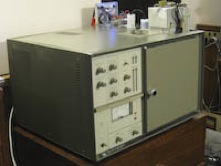Hewlett Packard 5710A Gas Chromatograph
Updated 9 November 2023

Introduction
The HP5710 Gas Chromatograph has been modified to run off two PEM fuel cells used as electrolisers of water. One fuel cell supplies hydrogen as a column carrier gas. The other larger fuel cell supplies hydrogen as a make-up gas to assist combustion in the flame ionisation detector. Air is added to the flame ionisation detector from a small aquarium pump connected to a regulating valve. This stabilises the flame.
Features
- Megabore columns are used with a dimethylsiloxane stationary phase.
- A 16-bit data logger digitises the amplified detector signals for processing on a PC.
- The fuel cells provide ultra-pure hydrogen which does not require further cleaning.
- Because the carrier gas is so pure a small DC offset is required to produce a positive baseline for the data logger.
Principle
A gas chromatograph sorts out gas mixtures according to the delay in passing through a chemically treated column. This delay is called the retention time. Heavier molecules tend to have longer retention times.
A heated inlet with a silicone rubber septum is used for introducing sample mixtures held in a small syringe. The sample mixture passes along the column driven by the hydrogen carrier. The mixture gradually separates into its component parts.
At the far end of the column the make-up hydrogen is added. All the hydrogen is burnt in the flame ionisation detector. When any hydrocarbons arrive, the flame produces ionisation which causes the flame to conduct electricity. The voltage bias required is usually about 250 volts. The signal is amplified and presented to the data logger.
Modifications
The fuel cells can be obtained here
Current 300mA
Voltage 0.65V
Dimensions 64 x 54 x 27mm
Current 850mA
Voltage 0.65V
Dimensions 64 x 54 x 27mm
A 6 volt 2.2 amp switch mode power supply is used to drive two LM317 regulators.
They are both connected as variable current sources.
The smaller fuel cell has a current range of 0.1 to 0.3 amps.
The larger fuel cell has a current range of 0.2 to 1.4 amps.
This generates sufficient hydrogen to run the flame ionisation detector.
The "Current" specification refers to operation as a fuel cell.
When operated as an electroliser a 1.4 amp maximum supply current is allowed for the larger cell.
At this current the hydrogen flow is claimed to be 10ml per minute.
The maximum supply current for the smaller cell is 0.5 amps.
With the added output of the smaller fuel cell combustion can be easily started and sustained in the detector.
The air flow from the aquarium pump is increased until the flame goes out with a pop. The valve is then backed off a little from this setting for sustained use.
The fuel cells are all hydrated from a single water tank supplying the oxygen side of each fuel cell. The lower and upper ports are connected to the tank at corresponding levels. The fuel cells are continuously hydrated as bubbling of oxygen only occurs at the upper ports. A syringe can help to initially draw water through if bubbling occurs at the bottom. Thereafter the water is circulated with the released oxygen.


JEPSPECTRO - Home Page
Email: replace at with @
jepattersonatactrix.co.nz
Click the photos below to enlarge. Use the browser "back control" to return.
 HP5710A Gas Chromatograph.
HP5710A Gas Chromatograph.
 HP5710A GC.
HP5710A GC.
 GC program.
GC program.
 TabDVM ion plot.
TabDVM ion plot.